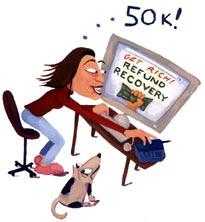I have always been tempted by offers promising that my laziness and lack of skill are the perfect qualifications for making lots of money in my spare time. For “Human Guinea Pig,” a column in which I explore intriguing, sometimes idiotic parts of life everyone wants someone else to check out for them, I decided to answer one of these e-mail solicitations and get rich, quick.
There were so many spams to choose from. One promised I could make $150 an hour giving my opinion. Since I sit at my desk and mumble it for free to my dog, this sounded unlikely. Then there was the classic—stuffing envelopes. But career advice books always tell you to push the envelope, not stuff it. Instead, I got sucked in by e-mail from a legitimate-sounding, techie outfit called Refund Recovery. The premise behind it is that both UPS and FedEx promise on-time delivery but don’t always achieve it. For $77 plus $11 shipping and handling, I would get the software that would allow me to track late deliveries, recover the refund, and split the money with my clients. This would result in a “$50K a year income stream” for working less than 10 hours a week from home.
The site was filled with testimonials from people who quit their jobs to recover refunds—a nurse, a teacher, a “staffing assistant.” George Milovic, a college student from Dallas offered: “It works, it really works, I’m actually making money working from home! I don’t mean to sound negative, I know this is supposed to be a testimonial, but I didn’t think it would work for me, I mean I hoped it would, but I really didn’t believe it would.” I looked up George’s phone number in Yahoo! so I could get advice on launching my own career in refund recovery, but I was unable to find a George Milovic listed anywhere in the United States. He’s probably living on a yacht in Monte Carlo.
A few days after I placed my order, two CDs arrived. (Actual cost of shipping via the U.S. Postal Service: $1.65.) I was terrified that loading the CDs would cause my computer to actually melt like the Wicked Witch, but fortunately I did not need to use the software until I received shipping data from customers. A curt enclosure directed me to begin my work with the company’s online training manual. There I encountered the $50,000 dam in my $50,000 income stream. I would have to find my own clients.
The anonymous writers of the training manual recognized and dispelled any discouragement resulting from this discovery: “If I ask someone for their business and they say no will my head explode[?] … Answer—Absolutely NOT.” They advised four methods for getting clients: sending letters, fax blasting, hiring a sales force, or telemarketing.
They acknowledged letters were a loser but advised, “Hand writing the envelopes, no return address, and oversized stamps will increase your chance of having your letter read.” I thought that would increase my chance of having my letter turned over to the authorities for possible anthrax contamination. I don’t know how to program my fax machine, so a fax blast was out. Hiring a sales force had a certain appeal. I imagined designing fetching uniforms and having company rallies where we shouted our slogan: “If they’re not on time, we make a dime!” But then I realized my employees would be bugging me about their 401(k)s and on-site child care, so I gave up on that idea. That left making phone calls.
In one paragraph the manual suggested—rather cruelly—that after 100 phone calls, only one company might sign up: “Ninety-nine people rejected you and your service, get used to it.” Three paragraphs later a more ominous estimate appeared: “The math is in your favor—if one out of 1000 say [sic] yes, you will be successful. … Now go get rejected and call me when you hear yes and I promise you, you will only remember the yes and none of the No’s.” (I tried calling in anticipation of my good news, but the only phone number listed in any of the Refund Recovery materials was out of order.)
So, I got to work. The Refund Recovery people suggested my best prospects were law firms, travel agencies, and catalogs. I compiled a list of law firms and travel agencies from the Yellow Pages, and selected the catalog companies from catalogs that came to the house.
I called the first law firm and asked for the shipping manager, as the training manual recommended.
“We don’t have one,” the receptionist said.
“Can I speak to someone who handles shipping?” I countered.
“Are you soliciting new business?”
“I can help you get your money back from UPS or FedEx for packages delivered late.”
“No thank you.” Click.
Since my head didn’t explode, I went on to the next law firm and asked for the shipping manager.
“Who’s calling, please?”
“Emily Yoffe?”
“Who are you with?”
“Refund Recovery.” As I said this, sweat appeared on my upper lip, and my underarms got clammy.

“He’s on the other line. You can leave a message or call back.” They have a shipping manager! I suddenly felt the first gushes of my income stream. I knew he would never return my call, so I said I’d call back. During the course of the day, I tried this shipping manager five more times, but he was always on the other line. Finally, around 4 p.m., I got through. The shipping manager didn’t sound happy to hear from me.
“I do want to talk to you because I don’t appreciate your calling so often and refusing to leave a message,” he said. “My receptionist says you’re driving her nuts. That’s the only reason I took this call.”
“Well, I wanted to talk to you in person,” I said. “And now that I have you on the phone, let’s talk about this exciting business offer!” I couldn’t believe how smooth I was—”this exciting business offer” wasn’t even in the training manual script.
“Let’s not,” said the shipping manager.
I decided to try catalog companies. The first one I called, for a company that sells stylish clothes for women who prefer elastic waistbands, actually put me through right away to the shipping manager. I gave my spiel.
“We have a company that audits all misdeliveries and late deliveries,” he said.
“You do?” I said. Could it be that Refund Recovery was a legitimate business? Could Dallas college student George Milovic have gotten here first?
“Yes. It’s a download that goes straight to them. We’re very happy with it.”
“Really?”
I managed to ask him the name of this wonderful service, but he didn’t know, and the guy who did was away. I hung up with a new sense of purpose, which was quickly shattered by all subsequent phone calls.
“We don’t do a lot of shipping. What we do we have no problem with, so I don’t know where you got your information.” Click.
“I handle all that, but thanks for calling.” Click.
“If things are late, we let them know, and they don’t charge us.” Click.
“I’m not able to connect you or give you the name of [the shipping manager], but I will take your information and forward it on.” Click.
“I’m busy. Can I call you back when I have more time?” Click.
“We tried this with other companies, and it’s too much of a hassle, so we’re not interested.” Click.
Stroke runs in my family, and as I made call after call, I could feel a pounding deep in my frontal lobe. I began to fear that despite the reassurances of the training manual, making those 1,000 calls to get that first customer might actually cause my head to explode. I repeatedly e-mailed the Refund Recovery customer service address (help@refundrecoverymanual.com) asking to be put in touch with George Milovic or some of the other people who said they were able to quit their jobs and live off their Refund Recovery money. I thought that instead of hiring my own staff, I could offer to work for them. I got one e-mail from someone named Abbe who gave me a list of more sales scripts (“Good morning. Your overnight carrier owes you thousands of dollars for late delivery and I can collect that money for you!”). After that, no one answered.
A Google search on George Milovic came up with two hits, one for Refund Recovery and one for something called the Real E-Gold Investment Scheme. The title was a nice touch, I thought, “scheme” being so much classier than “scam.” George and the same nurse and teacher who had quit their jobs to do Refund Recovery gave the same testimonials about the wonders of E-Gold. As I read them, I realized a career in Refund Recovery had about the same prospect of advancement as a job in the Iraq Ministry of Information.
The Federal Trade Commission takes a dim view of jobs that come to you through e-mail, that require you to pay to get started, and that are unlikely to yield a single client after 1,000 or 10,000 or 100,000 calls. Though the FTC does not specifically mention the wonders of Refund Recovery, you can read its warnings here.
After getting as close as I could to calling 1,000 companies—11 to be exact—I closed my business. But I had to find out if there were real companies doing refund recovery. This led me to Mark Taylor of Taylor Systems Engineering Corp. in Michigan, who creates shipping software for companies. He says he thinks he came up with the refund recovery business in the mid-’90s. “I started it, and I haven’t gotten rich from it,” he says. For a while he was getting back significant money for his clients and had enough business that he hired a staff. But neither UPS nor FedEx were amused by Taylor’s work. UPS wrote regulations that allow the company to exclude third parties from collecting refunds. And FedEx, he says, started offering high-volume customers a discount if they agreed not to track late fees. (FedEx declines to comment on contracts with clients.) The refund recovery part of Taylor’s business died.
He does however get calls and letters and e-mails from people like me who spent $88 to get into the refund recovery business. He says he never answers them.
